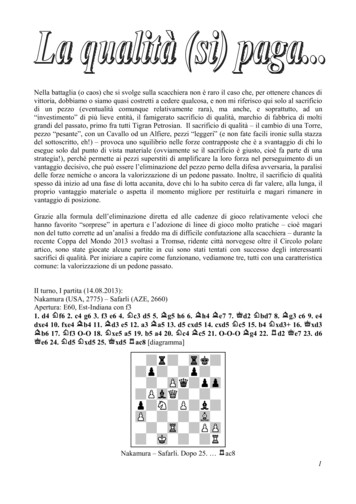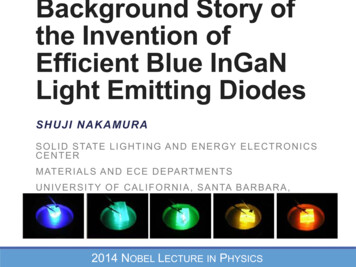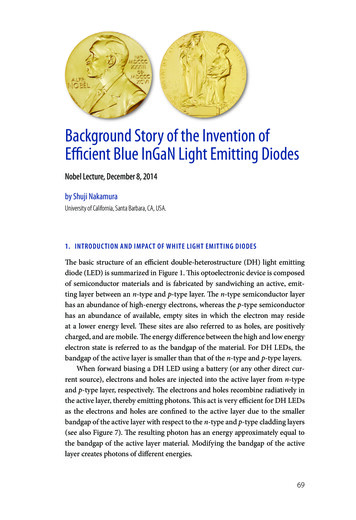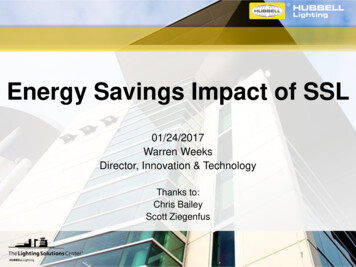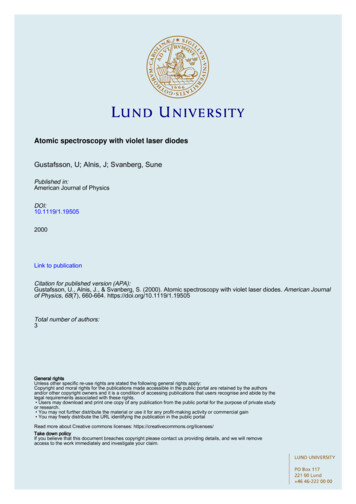
Transcription
S. Nakamura, S. Pearton, G. Fasol · The Blue Laser Diode
Springer-Verlag Berlin Heidelberg GmbHPhysics and AstronomyONLINE LIBRARYhttp://www.springer.de/phys/
Shuji Nakamura Stephen PeartonGerhard FasolThe Blue laser DiodeThe Complete StorySecond Updated and Extended EditionWith 256 Figures and 61 Tables'Springer
Shuji NakamuraStephen PeartonMaterials Dept.University of CaliforniaSanta Barbara CA 93106USAe-mail: ishuji@engineering.ucsb.eduUniversity of FloridaDept. of Materials Science and EngineeringRhines Hall, PO Box 116400Gainesville, FL 32611-6400USAe-mail: spear@mse.uft.eduGerhard FasolEurotechnology Japan Ltd.Parkwest Building nth Floor6-12-1 Nishi-ShinjukuShinjuku-ku, Tokyo 160Japane-mail: g.fasol@ieee.orgISBN 978-3-642-08579-6Library of Congress Cataloging-in-Publication Data applied for.Die Deutsche Bibliothek- CIP-EinheitsaufnallmeNakamura, Shuji:The blue laser diode : the complete story I Shuji Nakamura ; Stephen Pearton ; Gerhard Paso!. 2., updated and extended ed .(Physics and astronomy)ISBN 978-3-642-08579-6ISBN 978-3-662-04156-7 (eBook)DOI 10.1007/978-3-662-04156-7This work is subject to copyright. All rights are reserved, whether the whole or part of the materialis concerned, specifically the rights of translation, reprinting, reuse of illustrations, recitation, broadcasting, reproduction on microfilm or in any other way, and storage in data banks. Duplication ofthis publication or parts thereof is permitted only under the provisions of the German Copyright Lawof September 9, 1965, in its current version, and permission for use must always be obtained fromSpringer-Verlag Berlin Heidelberg GmbH.Violations are liable for prosecution under the German Copyright Law. Springer-Verlag Berlin Heidelberg 1997, 2000Originally published by Springer-Verlag Berlin Heidelberg New York in 2000Softcover reprint of the hardcover 2nd edition 2000The use of general descriptive names, registered names, trademarks, etc. in this publication does notimply, even in the absence of a specific statement, that such names are exempt from the relevant protective laws and regulations and therefore free for general use.Data conversion by LE T X Jelonek, Schmidt & Viickler GbR, LeipzigCover design: design & production GmbH, HeidelbergPrinted on acid-free paperSPIN: 1069540957/3144/mf54 3 21 o
PrefaceThis is a completely updated and revamped version of the first edition of thisbook, published in early 1997. Shuji Nakamura's development of commerciallight emitters from Gallium Nitride and related materials has propelled thesematerials into the mainstream of interest.It is very rare that a breakthrough of such proportion can be convertedso quickly into successful commercial products. One factor for this success isShuji Nakamura's hard work, another factor is Nichia's enlightened founder,Chairman and joint owner, Nobuo Ogawa without whom Nakamura probablycould not have done this work. Other factors include Professor Pankove's andProfessor Akasaki's pioneering work.One of the aims of the present book is to provide detailed informationon nitrides, and to provide a report on the development of Gallium Nitridebased light emitters and lasers and their properties. Both aims are rapidlymoving targets.The present book also documents an amazing success story of great historical importance. At the time when Nichia's Chairman Nobuo Ogawa gaveShuji Nakamura several million dollars budget to 'gamble' on GaN research,Nakamura was an unknown 36 old engineer, without a Ph.D., without a singlepublication, and no commercially successful product developments. Maybethis story has some more general relevance at a time when we can observethat scientific research is being rapidly reengineered everywhere, so that itsurvives or, even better, leads a rapidly and profoundly changing world.Silicon circuits have replaced vacuum tubes in radios and computers.Gallium-Nitrides (together with other compound semiconductors) may wellsoon replace light bulbs and fluorescent tubes in a similar way. They alsohave applications in high temperature electronics.Santa BarbaraTokyoGainesvilleJune 2000Shuji NakamuraGerhard FasolStephen Pearton
Foreword by Shuji NakamuraThis book is written about III-V nitride materials such as GaN, InGaN,AlGaN, AlGainN, their crystal growth, blue/green/yellow/white light emitting diodes (LEDs), purplish-blue laser diodes (LDs) and their applications.Why should III-V nitride materials be described in this book? You probablyhave some questions about the motivations. First, considering environmentalissues, III-V nitride materials will become very important because they willreduce energy consumption by replacing conventional light sources such aslight bulbs or fluorescent lamps. Using III-V nitride materials we can alreadyfabricate highly efficient long-lifetime solid state light sources such as LEDsand LDs instead of conventional vacuum tube light bulbs which were developed by Thomas Alva Edison in 1879 1 . Edison's electrical light bulbs replacedgas lighting soon after their invention. Using these solid state light sourcesenergy consumption would be reduced to 1/5 in comparison with that of conventional light bulbs. Also, the lifetime of III-V nitride based LEDs is morethan 106 hours, i.e. almost forever. On the other hand, the lifetime of conventional light bulbs is less than 103 hours. Using LEDs as light sources, weno longer need replacements for burned lamps after installing. Thus we couldreduce the number of nuclear power plants worldwide by saving energy usingIII-V nitride based solid state light sources instead of conventional vacuumtube light sources. Also, III-V nitride materials are not toxic to humans, incontrast to conventional II-VI or III-V compound semiconductor materials.The safety of materials is very important for many private and public applications to be carried out under safe and healthy conditions. Thus, from theenvironmental viewpoint, people should have some knowledge about these issues and consider the use of III-V nitride based LEDs for many applicationsto reduce energy consumption and in order to protect our environment.The III-V nitride based materials system is a mysterious material from theviewpoint of physics because the performance of blue/ green GaN based LEDsis superior to conventional red GaAlAs and AllnGaP LEDs with respect tooutput power and reliability, in spite of the large number of crystal defects(to the order of 10 10 cm 2 ). Also, the lifetime of InGaN based multi-quantumwell structure LDs is now more than 10 000 hours under RT CW operation. It1US-Patent No. 223,898
VIIIForeword by Shuji Nakamuraseems that dislocations in III-V nitride materials do not work as very effectivenonradiative recombination centers.I started III-V nitride based LED research in 1989 after leaving a study ofGaAs bulk crystal growth and AlGaAs liquid phase epitaxial (LPE) growthat my previous company. At that time, nobody could imagine the presentpopularity of III-V nitride semiconductors and device performance such ashigh-brightness blue/ green LEDs and violet LDs using III-V nitride materials. During the period 1989 - 1992, I attended several domestic conferencesto study the GaN research of other groups. It was surprising that the numberof participants was so small (only a few people in addition to the speaker)at the nitride sessions. On the other hand, the number of participants forZnSe sessions was huge - more than 500 people - at Japanese domestic conferences. This trend became even greater after the success of the first laseroscillations using ZnSe based materiels in 1991 by the 3M group. Nobodycould have imagined at that time that the popularity of GaN and ZnSe couldbe completely reversed within a few years. This is an amazing developmentof physics research.I joined Nichia Chemical Industries Ltd. in 1979 at a time when it wasstill a very small company (the number of employees was about 200). Nichiawas a chemical company and not a semiconductor company. The company'sspeciality was the production of phosphors for color cathode ray (CRT) tubesand for fluorescent lamps (the worldwide market share is about 30% now). Iwas assigned to the R & D department on joining the company, and I startedsemiconductor research such as GaP, GaAs bulk crystal growth and GaAlAsLPE growth for the red and infrared LED markets with no special knowledgeof compound semiconductors, with no assistant staff, and with no collaboration with other universities and companies, nor with large funds since Nichiawas a small fragile company. I spent a lot of effort to develop these products. However, the sales of these products were not good, despite successes inproduction, due to the severe competition from other Japanese giant semiconductor companies. Thus, I spent ten years on III-V compound bulk crystalgrowth and LPE growth without any business success. My company was nothappy with the outcome of my research because the resulting business waspoor. Dissatisfied with the lack of commercial succes of my research, and Ichanged my research subject to blue LEDs using III-V nitride materials because there was no competition in the area of III-V nitride based blue LEDsand LDs from any big companies in 1989. All big companies and universitieswere doing ZnSe research for blue emitters at that time. That was my mostimportant reason for selecting III-V nitride materials for blue emitters, sincemy previous research had always been in competition with big companies.What I have managed to achieve shows that anybody with relatively littlespecial experience in a field, no big money and no collaborations with otheruniversities and companies, can achieve considerable research success alonewhen he tries a new research area without being obsessed by conventional
Foreword by Shuji NakamuraIXideas and knowledge. This book focuses on studying how to approach research in a totally new area, taking research on GaN based LEDs and LDsas one example. Of course, this book is also good for studying environmentalprotection.Many people have cooperated in the development of III-V nitride basedblue/green LEDs and LDs in my R&D department. Among them I would liketo thank Mr. Takashi Mukai, Masayuki Senoh, Shin-ichi Nagahama, NaruhitoIwasa, Takao Yamada, Toshio Matsushita, Hiroyuki Kiyoku and YasunobuSugimoto for their assistance in the experiments. I also thank Springer-Verlagfor their interest and willing cooperation in the preparation of the book. However, my special thanks are due to my wife and three daughters whose understanding and forbearance have made it possible to me to work undisturbed.Anan, Tokushima-ken, JapanShuji Nakamura
Contents1.Introduction . . . . . . . . . . . . . . . . . . . . . . . . . . . . . . . . . . . . . . . . . . . . . .1.1 LEDs and LDs . . . . . . . . . . . . . . . . . . . . . . . . . . . . . . . . . . . . . . . . .1.2 Group-III Nitride Compound Semiconductors . . . . . . . . . . . . . .1132.Background . . . . . . . . . . . . . . . . . . . . . . . . . . . . . . . . . . . . . . . . . . . . . .2.1 Introduction . . . . . . . . . . . . . . . . . . . . . . . . . . . . . . . . . . . . . . . . . . .2.2 Applications and Markets for Gallium Nitride Light EmittingDiodes (LEDs) and Lasers . . . . . . . . . . . . . . . . . . . . . . . . . . . . . . .2.3 Who Were the Early Key Players in the Field? . . . . . . . . . . . . .2.4 Why InGaN / AlGaN? . . . . . . . . . . . . . . . . . . . . . . . . . . . . . . . . . . .2.5 Key Steps in the Discovery- Materials Issues . . . . . . . . . . . . . .2.5.1 Research History of Shuji Nakamuraand Selected Steps in the Developmentof the Commercial Blue GaN LED. . . . . . . . . . . . . . . . . .2.6 Why Did Nichia Succeed Where Many Much LargerMultinationals and Research Groups Failed? . . . . . . . . . . . . . . .2. 7 Additional Comments on Blue LED Research . . . . . . . . . . . . . .2.8 A Short Summary of the Physics of Semiconductor Lasersand LEDs . . . . . . . . . . . . . . . . . . . . . . . . . . . . . . . . . . . . . . . . . . . . .2.8.1 LEDs . . . . . . . . . . . . . . . . . . . . . . . . . . . . . . . . . . . . . . . . . . .2.8.2 Lasers . . . . . . . . . . . . . . . . . . . . . . . . . . . . . . . . . . . . . . . . . .773.Physics of Gallium Nitride and Related Compounds . . . . . .3.1 Introduction . . . . . . . . . . . . . . . . . . . . . . . . . . . . . . . . . . . . . . . . . . .3.2 Crystal Structures . . . . . . . . . . . . . . . . . . . . . . . . . . . . . . . . . . . . . .3.2.1 Wurtzite versus Zincblende Structure . . . . . . . . . . . . . . .3.2.2 Growth of Wurtzite GaN onto Sapphire . . . . . . . . . . . . .3.2.3 Growth of Cubic (Zincblende) GaN.3.2.4 Growth of GaN onto Other Substrates . . . . . . . . . . . . . .3.3 Electronic Band Structure . . . . . . . . . . . . . . . . . . . . . . . . . . . . . . .3.3.1 Fundamental Optical Transitions . . . . . . . . . . . . . . . . . . .3.3.2 Band Structure Near the Fundamental Gap.3.3.3 Band Parameters and Band Offsets forGaN, AlN,and InN .71011131517202123242929292931313232343536
XIIContents3.43.5Elastic Properties - Phonons. . . . . . . . . . . . . . . . . . . . . . . . . . . . .Other Properties of Gallium Nitride . . . . . . . . . . . . . . . . . . . . . .3.5.1 Negative Electron Affinity (NEA) . . . . . . . . . . . . . . . . . .3.5.2 Pyroelectricity . . . . . . . . . . . . . . . . . . . . . . . . . . . . . . . . . . .3.5.3 Transferred-Electron Effect (Gunn Effect) . . . . . . . . . . .Summary of Properties.383841414142GaN Growth . . . . . . . . . . . . . . . . . . . . . . . . . . . . . . . . . . . . . . . . . . . . .4.1 Growth Methods for Crystalline GaN . . . . . . . . . . . . . . . . . . . . .4.2 A New Two-Flow Metalorganic ChemicalVapor Deposition System forGaN Growth (TF-MOCVD) . . .4.3 In Situ Monitoring of GaN Growth Using Interference Effects4.3.1 Introduction . . . . . . . . . . . . . . . . . . . . . . . . . . . . . . . . . . . . .4.3.2 Experimental Details . . . . . . . . . . . . . . . . . . . . . . . . . . . . .4.3.3 GaN Growth Without AlN Buffer Layer . . . . . . . . . . . . .4.3.4 GaN Growth with AlN Buffer Layer . . . . . . . . . . . . . . . .4.3.5 Summary. . . . . . . . . . . . . . . . . . . . . . . . . . . . . . . . . . . . . . . .4.4 Analysis of Real-Time Monitoring Using Interference Effects .4.4.1 Introduction . . . . . . . . . . . . . . . . . . . . . . . . . . . . . . . . . . . . .4.4.2 Experimental Details . . . . . . . . . . . . . . . . . . . . . . . . . . . . .4.4.3 Results and Discussion. . . . . . . . . . . . . . . . . . . . . . . . . . . .4.4.4 Summary. . . . . . . . . . . . . . . . . . . . . . . . . . . . . . . . . . . . . . . .4.5 GaN Growth Using GaN Buffer Layer.4.5.1 Introduction.4.5.2 Experimental Details . . . . . . . . . . . . . . . . . . . . . . . . . . . . .4.5.3 Results and Discussion . . . . . . . . . . . . . . . . . . . . . . . . . . . .4.6 In Situ Monitoring and Hall Measurements of GaN Growthwith GaN Buffer Layers . . . . . . . . . . . . . . . . . . . . . . . . . . . . . . . . .4.6.1 Introduction . . . . . . . . . . . . . . . . . . . . . . . . . . . . . . . . . . . . .4.6.2 Experimental Details . . . . . . . . . . . . . . . . . . . . . . . . . . . . .4.6.3 Results and Discussion . . . . . . . . . . . . . . . . . . . . . . . . . . . .4.6.4 Summary. . . . . . . . . . . . . . . . . . . . . . . . . . . . . . . . . . . . . . . .47473.64.5.p-Type GaN Obtained by Electron Beam Irradiation . . . . .5.1 Highly p-Type Mg-Doped GaN Films Grownwith GaN Buffer Layers . . . . . . . . . . . . . . . . . . . . . . . . . . . . . . . . .5.1.1 Introduction . . . . . . . . . . . . . . . . . . . . . . . . . . . . . . . . . . . . .5.1.2 Experimental Details . . . . . . . . . . . . . . . . . . . . . . . . . . . . .5.1.3 Results and Discussion. . . . . . . . . . . . . . . . . . . . . . . . . . . .5.2 High-Power GaN p-n Junction Blue Light Emitting Diodes . .5.2.1 Introduction . . . . . . . . . . . . . . . . . . . . . . . . . . . . . . . . . . . . .5.2.2 Experimental Details . . . . . . . . . . . . . . . . . . . . . . . . . . . . .5.2.3 Results and Discussion . . . . . . . . . . . . . . . . . . . . . . . . . . . .5.2.4 Summary 99095959596101
ContentsXIII6.n-Type GaN .6.1 Si- and Ge-Doped GaN Films Grown with GaN Buffer Layers6.2 Experimental Details .6.3 Si Doping .6.4 Ge Doping. . . . . . . . . . . . . . . . . . . . . . . . . . . . . . . . . . . . . . . . . . . . .6.5 Mobility as a Function of the Carrier Concentration .6.6 Summary .1031031041041081111127.p-Type GaN .7.1 History of p-Type GaN Research .7.2 Thermal Annealing Effects on p-Type Mg-Doped GaN Films.7.2.1 Introduction .7.2.2 Experimental Details .7.2.3 Results and Discussion .7.2.4 Appendix .7.3 Hole Compensation Mechanism of p-Type GaN Films .7.3.1 Introduction .7.3.2 Experimental Details .7.3.3 Results and Discussion: Explanationof the Hole Compensation Mechanism of p-Type GaN.7.3.4 Summary: Hydrogen Passivation and Annealingof p-Type GaN . . . . . . . . . . . . . . . . . . . . . . . . . . . . . . . . . . .7.4 Properties and Effects of Hydrogen in GaN .7.4.1 Present State of Knowledge .7.4.2 Passivation .7.4.3 Hydrogen in As-Grown GaN .7.4.4 Diffusion of H in Implanted or Plasma-Treated GaN .7.4.5 Summary .113113114114114114119120120120InGaN .8.1 Introductory Remarks: The Role of Lattice Mismatch .8.2 High-Quality InGaN Films Grown on GaN Films .8.2.1 Introduction: InGaN on GaN .8.2.2 Experimental Details: InGaN on GaN .8.2.3 Results and Discussion: InGaN on GaN .8.2.4 Summary: InGaN on GaN .8.3 Si-Doped InGaN Films Grown on GaN Films .8.3.1 Introduction: Si-Doped InGaN on GaN .8.3.2 Experimental Details: Si-Doped InGaN on GaN .8.3.3 Results and Discussion: Si-Doped InGaN on GaN .8.3.4 Summary: Si-Doped InGaN on GaN .8.4 Cd-Doped InGaN Films Grown on GaN Films .8.4.1 Introduction: Cd-doped InGaN on GaN .8.4.2 Experimental Details .8.4.3 Results and Discussion .8.4.4 Summary: Cd-Doped InGaN 668.121135136137140141145147
XIVContentsInxGa 1 -xNIInyGa 1 yN Superlattices Grown on GaN Films .8.5.1 Introduction: InxGal-xNIInyGal-yN Superlattices .8.5.2 Experiments: InxGal-xNIInyGal-yN Superlattices .8.5.3 Results and Discussion:InxGal-xNIInyGa 1 -yN Superlattices .8.5.4 Summary: InxGa1 xNIInyGal-yN Superlattices .8.6 Growth of InxGa1 xN Compound Semiconductorsand High-Power InGaNI AlGaN Double HeterostructureViolet Light Emitting Diodes . . . . . . . . . . . . . . . . . . . . . . . . . . . .8.6.1 Introduction .8.6.2 Experimental Details .8.6.3 Growth and Propertiesof InxGa 1 -xN Compound Semiconductors .8.6.4 High Power InGaN I AlGaN Double HeterostructureViolet Light Emitting Diodes .8.6.5 Summary .8.7 p-GaNin-InGaNin-GaN Double-Heterostructure Blue LightEmitting Diodes . . . . . . . . . . . . . . . . . . . . . . . . . . . . . . . . . . . . . . . .8.7.1 Experimental Details .8.7.2 Results and Discussion .8.7.3 Summary .8.8 High-Power InGaNIGaN Double-Heterostructure Violet LightEmitting Diodes . . . . . . . . . . . . . . . . . . . . . . . . . . . . . . . . . . . . . . . 8188Zn and Si Co-Doped InGaN/ AlGaN Double-HeterostructureBlue and Blue-Green LEDs . 1939.1 Zn-Doped InGaN Growth and InGaNIAlGaNDouble-Heterostructure Blue Light Emitting Diodes . 1939.1.1 Introduction . 1939.1.2 Experimental Details . 1949.1.3 Zn-Doped InGaN . 1949.1.4 InGaNIAlGaN DH Blue LEDs . 1989.2 Candela-Class High-Brightness InGaN I AlGaNDouble-Heterostructure Blue Light Emitting Diodes . 2019.3 High-Brightness InGaNI AlGaN Double-HeterostructureBlue-Green Light Emitting Diodes . 2039.4 A Bright Future for Blue-Green LEDs . 2079.4.1 Introduction . 2079.4.2 GaN Growth . 2099.4.3 InGaN . 2099.4.4 InGaNI AlGaN DH LED . 2099.4.5 Summary . 214
ContentsXV10. InGaN Single-Quantum-Well LEDs .10.1 High-Brightness InGaN Blue, Green, and Yellow LEDswith Quantum-Well Structures .10.1.1 Introduction .10.1.2 Experimental Details .10.1.3 Results and Discussion .10.1.4 Summary .10.2 High-Power InGaN Single-Quantum-Well Blueand Violet Light Emitting Diodes .10.3 Super-Bright Green InGaN Single-Quantum-Well LightEmitting Diodes . . . . . . . . . . . . . . . . . . . . . . . . . . . . . . . . . . . . . . . .10.3.1 Introduction .10.3.2 Experimental Details .10.3.3 Results and Discussion .10.3.4 Summary .10.4 White LEDs .21511. Room-Temperature Pulsed Operation of Laser Diodes .11.1 InGaN-Based Multi-Quantum-Well Laser Diodes .11.1.1 Introduction .11.1.2 Experimental Deatils .11.1.3 Results and Discussion .11.1.4 Summary .11.2 InGaN Multi-Quantum-Well Laser Diodeswith Cleaved Mirror Cavity Facets . . . . . . . . . . . . . . . . . . . . . . . .11.2.1 Introduction .11.2.2 Experimental Details .11.2.3 Results and Discussion .11.2.4 Summary .11.3 InGaN Multi-Quantum-Well Laser Diodes Grown on MgAb0 4Substrates .11.3.1 Characteristics of InGaN Multi-Quantum-WellLaser Diodes . . . . . . . . . . . . . . . . . . . . . . . . . . . . . . . . . . . . .11.4 The First III-V-Nitride-Based Violet Laser Diodes .11.4.1 Introduction .11.4.2 Experimental Details .11.4.3 Results and Discussion . . . . . . . . . . . . . . . . . . . . . . . . . . . .11.4.4 Summary .11.5 Optical Gain and Carrier Lifetimeof InGaN Multi-Quantum-Well Laser Diodes .11.6 Ridge-Geometry InGaN Multi-Quantum-Well Laser Diodes .11.7 Longitudinal Mode Spectra and Ultrashort Pulse Generationof InGaN Multi-Quantum-Well Laser Diodes 29230242242242244247247252256256256258262262268273
XVIContents12. Emission Mechanisms of LEDs and LDs .12.1 InGaN Single-Quantum-Well (SQW)-Structure LEDs .12.2 Emission Mechanism of SQW LEDs .12.3 InGaN Multi-Quantum-Well (MQW)-Structure LDs .12.4 Summary .27927928128428913. Room Temperature CW Operation of InGaN MQW LDs .13.1 First Continuous-Wave Operation of InGaNMulti-Quantum-Well-Structure Laser Diodes at 233 K .13.2 First Room-Temperature Continuous-Wave Operationof InGaN Multi-Quantum-Well-Structure Laser Diodes .13.5 RT CW Operation of InGaN MQW LDswith a Long Lifetime .13.6 Blue/Green Semiconductor Laser .13.6.1 Blue/Green LEDs .13.6.2 Bluish-Purple LDs .13.6.3 Summary .13.7 RT CW InGaN MQW LDs with improved Lifetime .29129129630130530530731331414. Latest Results: Lasers with Self-Organized InGaN QuantumDots . 31914.1 Introduction . 31914.2 Fabrication . 31914.3 Emission Spectra . 32014.4 Self-Organized InGaN Quantum Dots . 32514.5 Advances in LEDs . 32614.6 Advances in Laser Diodes . 32815. Conclusions . 33515.1 Summary . 33515.2 Outlook . 336Appendix . 339Biographies .Shuji Nakamura . . . . . . . . . . . . . . . . . . . . . . . . . . . . . . . . . . . . . . . . . . . .Gerhard Fasol .Stephen Pearton . . . . . . . . . . . . . . . . . . . . . . . . . . . . . . . . . . . . . . . . . . . .343343344345References . . . . . . . . . . . . . . . . . . . . . . . . . . . . . . . . . . . . . . . . . . . . . . . . . . . . 347Index . 361
could have imagined at that time that the popularity of GaN and ZnSe could be completely reversed within a few years. This is an amazing development of physics research. I joined Nichia Chemical Industries Ltd. in 1979 at a time when it was still a very small company (the nu
